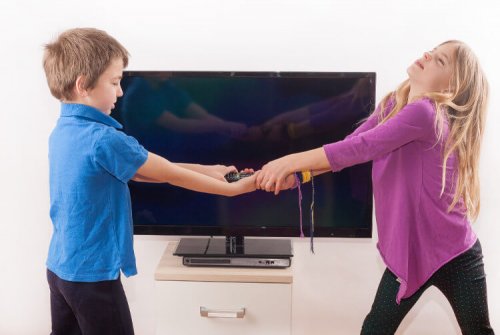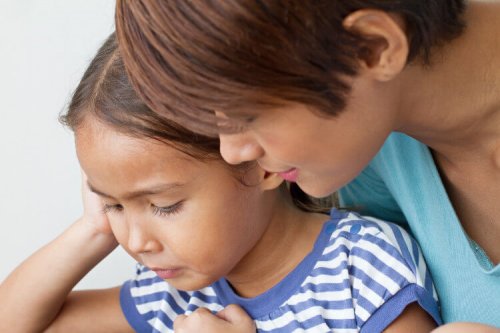How to Teach Problem-Solving Skills to Kids

Being able to solve problems on their own is a fundamental life skill that children should start learning early on in life. After all, children will very soon start to deal with various types of problems and, if we don’t teach problem-solving skills effectively, they’ll end up learning other ways of doing things.
How to deal with a problem, how to deal with frustration, or how to deal with the people with whom we come into conflict are some of the issues that are associated with problem-solving. If we teach children to deal with these conflictive situations, we’ll be helping to keep them from picking up habits that are very difficult to eradicate later in all these areas.
At the same time, learning to resolve problems and conflicts is also a way of training children in decision-making. Teaching children to make healthy decisions is another of the important tasks that parents must take on with their children. When children learn problem-solving skills, they also learn that they can trust their ability to make good decisions for themselves.
Detect and evaluate problems
The biggest problem that many children who lack problem-solving skills face is that they don’t recognize when they have a problem or they’re not able to evaluate what options they have to solve it. These children may react impulsively, without thinking. The first step is to help children learn how identifying their options can help ensure they’re making healthy choices.
Therefore, the main thing is to start by teaching children how to identify the problem. Sometimes, simply by identifying the problem, it’s possible to go a long way in its resolution. Once children identify the problem, they need to be taught to develop several possible solutions before doing anything else. In addition to identifying their options, children must be able to see their pros and cons and assess them to find the one that suits them best and why.
Once a child recognizes several options and the possible consequences of each, they must decide which option is best. At this point, it’s vitally important to teach children that if they choose one option and the problem isn’t solved, they can always try something else to encourage them to keep trying to solve a problem until it’s solved.

Discuss problem-solving with the child
When problems arise for children, there’s no need to run to try to solve them yourself. If a child has a problem, give them the opportunity to identify it and solve it themself before helping, even if the child is under some stress. It’s an excellent learning opportunity, as well as an ideal time to teach them new skills. Of course, if there’s a safety problem, intervene immediately.
In addition, when we decide that help is needed, what parents should do is guide them, help them think, offer them a problem-solving model, and discuss with them the different options and how to act, step by step.
Not letting children suffer or wanting to make things easier for them by interfering in their life isn’t a way to help children, but rather to make them dependent and to create self-esteem and self-confidence problems. Talking to them means helping them open their minds, not dictating what to do.

Allow natural consequences in order to teach problem-solving skills to kids
When children are allowed to experience the natural consequences of their decisions, learning problem-solving skills is more effective. While it’s important to make sure there are no safety issues, kids need to feel what’s happening, even if it’s a negative consequence.
Not letting children experience the natural consequences of their decisions won’t stimulate them to think about how to act and will give them false confidence in their ability to decide. Only by experiencing what really happens will they be able to find alternative options or explore other paths that satisfy them more.
In addition, these natural consequences are a learning opportunity that allows us parents to help work with our children to solve problems and will be remembered in later decisions.
Being able to solve problems on their own is a fundamental life skill that children should start learning early on in life. After all, children will very soon start to deal with various types of problems and, if we don’t teach problem-solving skills effectively, they’ll end up learning other ways of doing things.
How to deal with a problem, how to deal with frustration, or how to deal with the people with whom we come into conflict are some of the issues that are associated with problem-solving. If we teach children to deal with these conflictive situations, we’ll be helping to keep them from picking up habits that are very difficult to eradicate later in all these areas.
At the same time, learning to resolve problems and conflicts is also a way of training children in decision-making. Teaching children to make healthy decisions is another of the important tasks that parents must take on with their children. When children learn problem-solving skills, they also learn that they can trust their ability to make good decisions for themselves.
Detect and evaluate problems
The biggest problem that many children who lack problem-solving skills face is that they don’t recognize when they have a problem or they’re not able to evaluate what options they have to solve it. These children may react impulsively, without thinking. The first step is to help children learn how identifying their options can help ensure they’re making healthy choices.
Therefore, the main thing is to start by teaching children how to identify the problem. Sometimes, simply by identifying the problem, it’s possible to go a long way in its resolution. Once children identify the problem, they need to be taught to develop several possible solutions before doing anything else. In addition to identifying their options, children must be able to see their pros and cons and assess them to find the one that suits them best and why.
Once a child recognizes several options and the possible consequences of each, they must decide which option is best. At this point, it’s vitally important to teach children that if they choose one option and the problem isn’t solved, they can always try something else to encourage them to keep trying to solve a problem until it’s solved.

Discuss problem-solving with the child
When problems arise for children, there’s no need to run to try to solve them yourself. If a child has a problem, give them the opportunity to identify it and solve it themself before helping, even if the child is under some stress. It’s an excellent learning opportunity, as well as an ideal time to teach them new skills. Of course, if there’s a safety problem, intervene immediately.
In addition, when we decide that help is needed, what parents should do is guide them, help them think, offer them a problem-solving model, and discuss with them the different options and how to act, step by step.
Not letting children suffer or wanting to make things easier for them by interfering in their life isn’t a way to help children, but rather to make them dependent and to create self-esteem and self-confidence problems. Talking to them means helping them open their minds, not dictating what to do.

Allow natural consequences in order to teach problem-solving skills to kids
When children are allowed to experience the natural consequences of their decisions, learning problem-solving skills is more effective. While it’s important to make sure there are no safety issues, kids need to feel what’s happening, even if it’s a negative consequence.
Not letting children experience the natural consequences of their decisions won’t stimulate them to think about how to act and will give them false confidence in their ability to decide. Only by experiencing what really happens will they be able to find alternative options or explore other paths that satisfy them more.
In addition, these natural consequences are a learning opportunity that allows us parents to help work with our children to solve problems and will be remembered in later decisions.
All cited sources were thoroughly reviewed by our team to ensure their quality, reliability, currency, and validity. The bibliography of this article was considered reliable and of academic or scientific accuracy.
- Elizabeth, E. T. S. (2016). La sobreprotección familiar y su incidencia en el proceso de enseñanza-aprendizaje de los estudiantes del quinto año de educación básica de la Escuela Manuela Espejo de la parroquia Huachi Loreto del cantón Ambato provincia de Tungurahua (Bachelor’s thesis, Universidad Tècnica de Ambato. Facultad de Ciencias Humanas y de la Educaciòn. Carrera de Educaciòn Bàsica).
- Ison, M. S., & Morelato, G. S. (2011). Contexto Familiar y desarrollo de Habilidades Cognitivas para la Resolución de Problemas Interpersonales en niños. Psykhe, 11(1). http://psykhe.cl/index.php/psykhe/article/view/459
- Lantieri, L. (2010). Las emociones van a la escuela. National Geographic, Monográfico Cerebro y emociones, 1, 66-73.
- Manzanares, M. C. S., & Sánchez, J. M. R. (2011). Entrenamiento metacognitivo y estrategias de resolución de problemas en niños de 5 a 7 años. International Journal of Psychological Research, 4(2), 9-19. https://dialnet.unirioja.es/servlet/articulo?codigo=3904244
- Muñoz Rios, C. N. (2020) El juego de roles como estrategia didáctica para manejar conflictos de manera constructiva. https://tesis.pucp.edu.pe/repositorio/handle/20.500.12404/17668
- Ortiz Gómez, E. (2014). La empatía como base de la resolución de conflictos. https://repositorio.unican.es/xmlui/bitstream/handle/10902/5437/OrtizGomezEva.pdf?sequence
- Shapiro, L. E., & Tiscornia, A. (1997). La inteligencia emocional de los niños. Buenos Aires: Javier Vergara. Disponible en este enlace
This text is provided for informational purposes only and does not replace consultation with a professional. If in doubt, consult your specialist.








